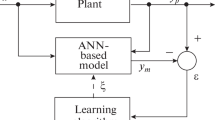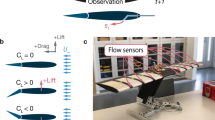Abstract
Aeroelastic systems have the peculiarity of changing their behavior with flight conditions. Within such a view, it is difficult to design a single control law capable of efficiently working at different flight conditions. Moreover, control laws are often designed on simple linearized, low-fidelity models, introducing the need of a scheduled tuning over a wide operational range. Obviously, such a design process can be time-consuming, because of the high number of simulations and flight tests required to assure high performance and robustness. The present work aims at proving the high flexibility of neural network-based controllers, testing their adaptive properties when applied to typical fixed and rotary-wing aircraft problems. At first, the proposed control strategy will be used to suppress the limit cycle oscillations experienced by a rigid wing in transonic regime. Then, as a second example, a controller with the same structure will be employed to reduce the hub vibrations of an helicopter rotor with active twist blades.














Similar content being viewed by others
References
Jacklin, S.A.: Closing the certification gaps in adaptive flight control software. In AIAA Guidance, Navigation and Control Conference, Honolulu, AIAA Paper, pp. 2008–6988 (2008)
Taylor, B., Darrah, M., Moats, C.: Verification and validation of neural networks: a sampling of research in progress. Intell. Comput. Theory Appl. 5103, 8–16 (2003)
Schumann, J., Gupta, P., Nelson, S.: On verification and validation of neural network based controllers. In: Proceedings of the Conference on Engineering applications in Neural Networks (EANN 03), Springer, Berlin (2003)
Mukhopadhyay, V.: Historical perspective on analysis and control of aeroelastic responses. J. Guid. Control Dyn. 26(5), 673–684 (2003)
Livne, E.: Future of airplane aeroelasticity. J. Aircr. 40(6), 1066–1092 (2003)
Murua, J., Martínez, P., Climent, H., van Zyl, L., Palacios, R.: T-tail flutter: potential-flow modelling, experimental validation and flight tests. Prog. Aerospace Sci. 71, 54–84 (2014)
Singh, S.N., Brenner, M.: Limit cycle oscillation and orbital stability in aeroelastic systems with torsional nonlinearity. Nonlinear Dyn. 31(4), 435–450 (2003)
Beran, P.S., Strganac, T.W., Kim, K., Nichkawde, C.: Studies of store-induced limit-cycle oscillations using a model with full system nonlinearities. Nonlinear Dyn. 37(4), 323–339 (2004)
Dowell, E.H.: Some recent advances in nonlinear aeroelasticity: fluid-structure interaction in the 21st century. In 51st AIAA/ASME/ASCE/AHS/ASC Structures, Structural Dynamics, and Materials Conference. American Institute of Aeronautics and Astronautics (2010)
Abdelkefi, A., Vasconcellos, R., Nayfeh, A.H., Hajj, M.R.: An analytical and experimental investigation into limit-cycle oscillations of an aeroelastic system. Nonlinear Dyn. 71(1–2), 159–173 (2013)
Guo, H., Chen, Y.: Supercritical and subcritical Hopf bifurcation and limit cycle oscillations of an airfoil with cubic nonlinearity in supersonic\(\backslash \)hypersonic flow. Nonlinear Dyn. 67(4), 2637–2649 (2012)
Zhang, W., Gao, C., Liu, Y., Ye, Z., Jiang, Y.: The interaction between flutter and buffet in transonic flow. Nonlinear Dyn. 82(4), 1851–1865 (2015)
Gang, C., Jian, S., Yueming, L.: Active flutter suppression control law design method based on balanced proper orthogonal decomposition reduced order model. Nonlinear Dyn. 70(1), 1–12 (2012)
Waszak, M.R.: Robust multivariable flutter suppression for the benchmark active control technology (BACT) wind-tunnel model. In: 11th Symposium on Structural Dynamics and Control, Blacksburg (1997)
Rubillo, C., Marzocca, P.: Active aeroelastic control of lifting surfaces via jet reaction limiter control. Int. J. Bifurc. Chaos 16, 2559–2574 (2006)
Wise, K.A., Lavretsky, E., Hovkimyan, N.: Adaptive control of flight: theory, applications, and open problems. In: Proceedings of the 2006 American Control Conference (2006)
Ko, J., Strganac, T.W., Kurdila, A.J.: Adaptive feedback linearization for the control of a typical wing section with structural nonlinearity. Nonlinear Dyn. 18(3), 289–301 (1999)
Chen, C.-L., Chang, C.-W., Yau, H.-T.: Terminal sliding mode control for aeroelastic systems. Nonlinear Dyn. 70(3), 2015–2026 (2012)
Lee, K.W., Singh, S.N.: Immersion- and invariance-based adaptive control of a nonlinear aeroelastic system. J. Guid. Control Dyn. 32(4), 1100–1110 (2009)
Scott, R.C., Pado, L.E.: Active control of wind tunnel model aeroelastic response using neural networks. J. Guid. Control Dyn. 23, 1100–1108 (2001)
Bernelli-Zazzera, F., Mantegazza, P., Mazzoni, G., Rendina, M.: Active Flutter suppression using recurrent neural networks. J. Guid. Control Dyn. 23, 1030–1037 (2000)
Mattaboni, M., Quaranta, G., Mantegazza, P.: Active flutter suppression for a three surface transport aircraft by recurrent neural networks. In 48th AIAA/ASME/ASCE/AHS/ASC Structures, Structural Dynamics and Materials Conference, Honolulu (2007)
Zong, Q., Wang, F., Tian, B., Su, R.: Robust adaptive dynamic surface control design for a flexible air-breathing hypersonic vehicle with input constraints and uncertainty. Nonlinear Dyn. 78(1), 289–315 (2014)
Xu, B.: Robust adaptive neural control of flexible hypersonic flight vehicle with dead-zone input nonlinearity. Nonlinear Dyn. 80(3), 1509–1520 (2015)
Ghorashi, M.: Nonlinear analysis of the dynamics of articulated composite rotor blades. Nonlinear Dyn. 67, 227–249 (2012)
Patt, D., Liu, L., Chandrasekar, J., Bernstein, D.S., Friedmann, P.P.: Higher-harmonic-control algorithm for helicopter vibration reduction revisited. J. Guid. Control Dyn. 28(5), 918–930 (2005)
Arcara, P., Bittanti, S., Lovera, M.: Periodic control of helicopter rotors for attenuation of vibrations in forward flight. IEEE Trans. Control Syst. Technol. 8(6), 883–894 (2000)
Ulker, F.D.: A New Framework For Helicopter Vibration Suppression; Time-Periodic System Identification and Controller Design. Ph.D. Thesis, Ottawa–Carleton Institute for Mechanical and Aerospace Engineering (2011)
Brillante, C., Morandini, M., Mantegazza, P.: H2 periodic control on active twist rotor for vibration reduction. In: AHS 70th Annual Forum and Technology Display, Montreal, Canada, 20–22 May (2014)
Stevens, B.L., Lewis, F.L.: Aircraft Control and Simulation. Wiley, New York (2003)
Bhoir, N., Singh, S.N.: Output feedback modular adaptive control of a nonlinear prototypical wing section. Nonlinear Dyn. 37(4), 357–373 (2004)
Zhu, B.: Nonlinear adaptive neural network control for a model-scaled unmanned helicopter. Nonlinear Dyn. 78, 1695–1708 (2014)
Romanelli, G., Serioli, E., Mantegazza, P.: A “Free” approach to computational aeroelasticity. In: 48th AIAA Aerospace Sciences Meeting and Exhibit, AIAA Paper 2010–0176, Orlando (2010)
Romanelli, G., Castellani, M., Mantegazza, P., Ricci, S.: Coupled CSD/CFD non-linear aeroelastic trim of free-flying flexible aircraft. In: 53rd AIAA/ASME/ASCE/AHS/ASC Structures, Structural Dynamics and Materials Conference, Honolulu (2012)
Masarati, P., Morandini, M., Mantegazza, P.: An efficient formulation for general-purpose multibody/multiphysics analysis. ASME J. Comput. Nonlinear Dyn. 9(4), 041001 (2014)
Haykin, S.: Neural Networks and Learning Machines: A Comprehensive Foundation. Prentice Hall, Upper Saddle River (2008)
Williams, R.J., Zipser, D.: A learning algorithm for continually running fully recurrent neural networks. Neural Comput. 1(2), 270–280 (1989)
Waszak, M.R.: Modeling the Benchmark Active Control Technology Wind-Tunnel Model for Active Control Design Applications. Technical report, NASA (1998)
Mukhopadhyay, V.: Transonic Flutter suppression control law design and wind-tunnel test results. J. Guid. Control. Dyn. 23, 930–937 (2000)
Zhang, W., Wang, B., Ye, Z.: High efficient numerical method for limit cycle flutter analysis based on nonlinear aerodynamic reduced-order-model. In: 51st AIAA, ASME, ASCE, AHS, ASC Structures, Structural Dynamics and Material Conference, Orlando (2010)
Mannarino, A., Mantegazza, P.: Nonlinear aeroelastic reduced order modeling by recurrent neural networks. J. Fluids Struct. 48, 103–121 (2014)
Kelkar, A.G., Joshi, S.M.: Passivity-based robust control with application to benchmark active controls technology wing. J. Guid. Control. Dyn. 23, 938–947 (2000)
Waszak, M.R., Fung, J.: Parameter estimation and analysis of actuators for the BACT wind-tunnel model. In: 21th AIAA Atmospheric Flight Mechanics Conference, San Diego (1996)
Dieterich, O., Götz, J., DangVu, B., Haverdings, H., Masarati, P., Pavel, M., Jump, M., Genaretti, M.: Adverse rotorcraft-pilot coupling: recent research activities in Europe. In: 34th European Rotorcraft Forum (ERF) (2008)
Wilbur, M.L., Wilkie, W.K.: Active-twist rotor control applications for UAVs. In: 24th US Army Science Conference (2004)
Monner, H.P., Riemenschneider, J., Opitz, S., Schulz, M.: Development of active twist rotors at the German Aerospace Center (DLR). In: 52nd AIAA/ASME/ASCE/AHS/ASC Structures, Structural Dynamics and Materials Conference, Denver (2011)
Ghiringhelli, G.L., Masarati, P., Mantegazza, P.: Multibody implementation of finite volume C0 beams. AIAA J. 38(1), 131–138 (2000)
Ghiringhelli, G.L., Masarati, P., Mantegazza, P.: Characterisation of anisotropic, non-homogeneous beam sections with embedded piezo-electric materials. J. Intell. Mater. Syst. Struct. 8, 842–858 (1997)
Morandini, M., Chierichetti, M., Mantegazza, P.: Characteristic behavior of prismatic anisotropic beam via generalized eigenvectors. Int. J. Solids Struct. 47, 1327–1337 (2010)
Ghiringhelli, G.L., Masarati, P., Morandini, M., Muffo, D.: Integrated aeroservoelastic analysis of induced strain rotor blades. Mech. Adv. Mater. Struct. 15, 291–306 (2008)
Author information
Authors and Affiliations
Corresponding author
Rights and permissions
About this article
Cite this article
Brillante, C., Mannarino, A. Improvement of aeroelastic vehicles performance through recurrent neural network controllers. Nonlinear Dyn 84, 1479–1495 (2016). https://doi.org/10.1007/s11071-015-2583-2
Received:
Accepted:
Published:
Issue Date:
DOI: https://doi.org/10.1007/s11071-015-2583-2




